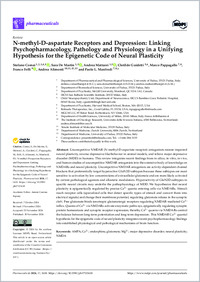N-methyl-D-aspartate receptors and depression : linking psychopharmacology, pathology and physiology in a unifying hypothesis for the epigenetic code of neural plasticity
- Comani, Stefano Department of Pharmaceutical and Pharmacological Sciences, University of Padua, Italy - Department of Biomedical Sciences, University of Padua, Italy - Department of Psychiatry, McGill University, Montreal, Canada - IRCSS San Raffaele Scientific Institute, Milan, Italy
- De Martin, Sara Department of Pharmaceutical and Pharmacological Sciences, University of Padua, Italy
- Mattarei, Andrea Department of Pharmaceutical and Pharmacological Sciences, University of Padua, Italy
- Guidetti, Clotilde Child Neuropsychiatry Unit, Department of Neuroscience, IRCCS Bambino Gesù Pediatric Hospital, Rome, Italy - Department of Psychiatry, Harvard Medical School, Boston, USA
- Pappagallo, Marco Relmada Therapeutics, Inc., Coral Gables, USA - MGGM LLC, Kerhonkson, USA
- Folli, Franco Department of Health Sciences, University of Milan, Italy
- Alimonti, Andrea ORCID Institute of Oncology Research (IOR), Faculty of Biomedical Sciences, Università della Svizzera italiana, Switzerland - Veneto Institute of Molecular Medicine, Padua, Italy - Department of Medicine, Zurich University, Switzerland - Department of Medicine, University of Padua, Italy
- Manfredi, Paolo L. Relmada Therapeutics, Inc., Coral Gables, USA - MGGM LLC, Kerhonkson, USA
- 2023
Published in:
- Pharmaceuticals. - 2023, vol. 17, no. 12, p. 1618
English
Uncompetitive NMDAR (N-methyl-D-aspartate receptor) antagonists restore impaired neural plasticity, reverse depressive-like behavior in animal models, and relieve major depressive disorder (MDD) in humans. This review integrates recent findings from in silico, in vitro, in vivo, and human studies of uncompetitive NMDAR antagonists into the extensive body of knowledge on NMDARs and neural plasticity. Uncompetitive NMDAR antagonists are activity-dependent channel blockers that preferentially target hyperactive GluN2D subtypes because these subtypes are most sensitive to activation by low concentrations of extracellular glutamate and are more likely activated by certain pathological agonists and allosteric modulators. Hyperactivity of GluN2D subtypes in specific neural circuits may underlie the pathophysiology of MDD. We hypothesize that neural plasticity is epigenetically regulated by precise Ca2+ quanta entering cells via NMDARs. Stimuli reach receptor cells (specialized cells that detect specific types of stimuli and convert them into electrical signals) and change their membrane potential, regulating glutamate release in the synaptic cleft. Free glutamate binds ionotropic glutamatergic receptors regulating NMDAR-mediated Ca2+ influx. Quanta of Ca2+ via NMDARs activate enzymatic pathways, epigenetically regulating synaptic protein homeostasis and synaptic receptor expression; thereby, Ca2+ quanta via NMDARs control the balance between long-term potentiation and long-term depression. This NMDAR Ca2+ quantal hypothesis for the epigenetic code of neural plasticity integrates recent psychopharmacology findings into established physiological and pathological mechanisms of brain function.
- Collections
- Language
-
- English
- Classification
- Medicine
- License
- Open access status
- gold
- Identifiers
-
- DOI 10.3390/ph17121618
- ARK ark:/12658/srd1331803
- Persistent URL
- https://n2t.net/ark:/12658/srd1331803
Statistics
Document views: 108
File downloads:
- Alimonti_2024_MDPI_pharmaceuticals_N-methyl-D-aspartate: 57
